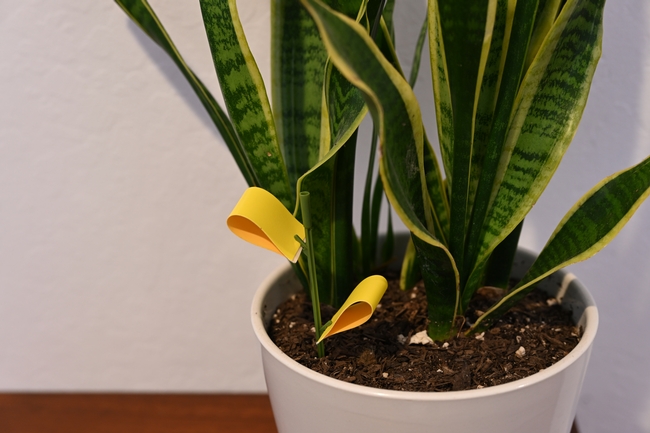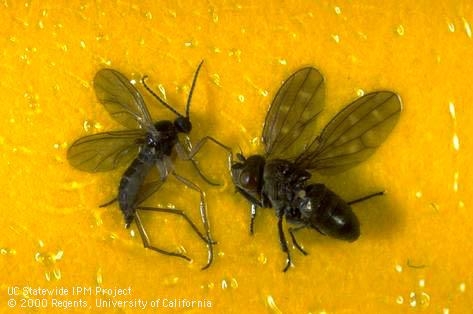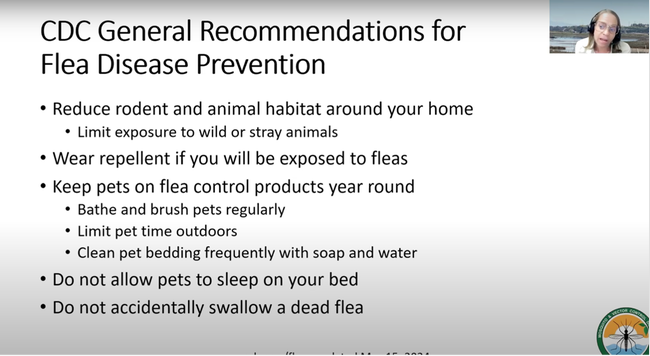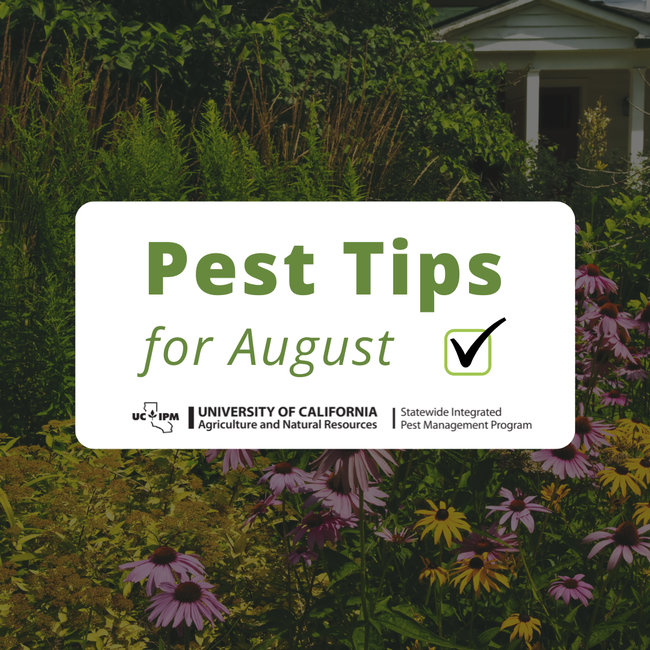If you've noticed tiny, dark insects flying around your houseplants, you likely have fungus gnats. These tiny flies can be a nuisance indoors and may also damage your plants.
Fungus gnats lay their eggs in moist soil and their larvae feed on plant roots and decaying organic matter. Because of this, the key to managing fungus gnats is to let the soil dry out in between watering and don't overwater plants. Water plants from the bottom using saucers under pots. This keeps the top of the soil dry, discouraging fungus gnats.
Sticky traps can be placed in pots or near plants to catch fungus gnat adults. This is also a great way to monitor for fungus gnats. Pesticides, including several biological pesticides like Bacillus thuringiensis subspecies israelensis (Bti), are available to control fungus gnats. However, the best way to control fungus gnats is by simply adjusting watering practices.
To learn more about fungus gnats and their management, visit Pest Notes: Fungus Gnats.
Just a few more weeks of summer remain! As the weather begins to shift, you may need to adjust your landscaping practices to prevent and monitor for fall pests. The UC IPM Seasonal Landscape IPM Checklist is a monthly guide to help you avoid common pests of landscape plants.
Here are some general tips for the month of September to prevent pests and their damage in the garden and landscape. Visit the checklist online to see more pest management to-dos for your region.
- Monitor citrus plants for signs of pests such as Asian citrus psyllid or leafminers.
- Adjust irrigation to account for any change in weather and increased rainfall.
- Inspect apple, citrus and especially Prunus species (e.g., stone fruit) for bacterial blast, blight, and canker. Remove entire affected branches in the summer, making cuts several inches away in healthy wood.
- Check for aphids. Most established plants can tolerate aphid feeding. On small plants, knock aphids off with a strong stream of water or apply insecticidal oils and soaps to manage.
- Check for signs of powdery mildew on apple, crape myrtle, grape, rose, and stone fruits.
- Manage ants around landscapes and building foundations using insecticide baits and trunk barriers.
- Look for leaffooted bugs feeding on fruit and nuts such as almonds, pistachios, and pomegranates.
Don't see your county on the checklist or want to provide feedback? Let us know!
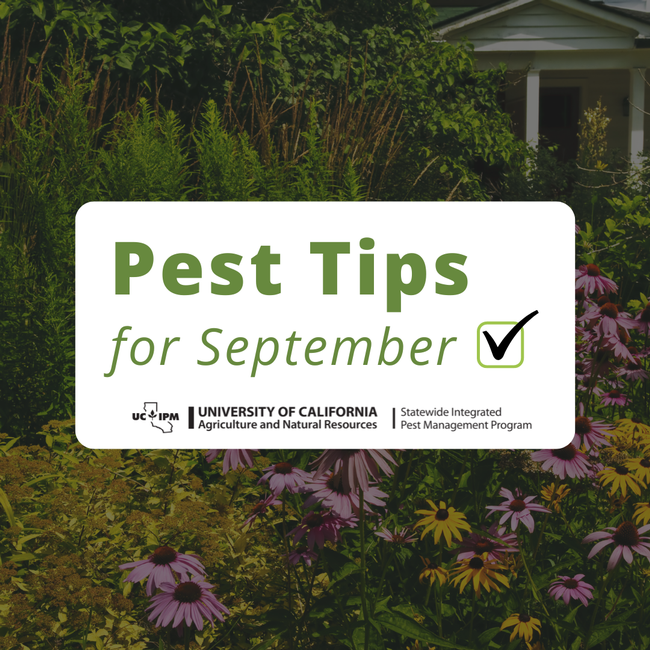
Nobody wants cockroaches in their home, especially since these pests can cause and worsen allergies in children, transmit diseases and bacteria, and contaminate foods.

If you find cockroaches in or around your home, do you reach for a do-it-yourself spray product? Well, you might not want to waste your money!
New research shows that some common consumer-grade insecticide sprays don't work to get rid of cockroach infestations. The study focused on products containing pyrethroids, which is a group of pesticides commonly found in many household insecticide products. Examples of pyrethroids include the active ingredients bifenthrin, cypermethrin, and permethrin.
In the study, both liquid and aerosol pyrethroid products killed less than 20% of German cockroaches on sprayed surfaces. Even when cockroaches were confined to the sprayed surfaces, most products took 8 to 24 hours to kill them, with some taking up to 5 days.
Research has also shown that frequent use of pyrethroid insecticides for cockroach management had caused the insects to develop resistance to these products.
So, what can you do to effectively control cockroaches?
Identifying the species present is important since some cockroaches live and breed indoors, while others live and breed outdoors. Knowing which cockroach species you have will allow you to focus control efforts on the correct location, using methods that are effective for managing that specific type of cockroach.
Pesticides alone will not solve a cockroach problem. Use pesticides indoors only if the cockroach population is reproducing and living in your home, not for the occasional intruder. Use insecticide bait products in combination with other non-chemical control methods, such as exclusion and sanitation.
Hiring a professional pest control service that takes an IPM approach can be helpful in reducing serious indoor cockroach infestations but can be also be expensive. Professionals have the tools, experience, and knowledge to better address serious pest issues. Infestations in multi-unit housing, such as apartment complexes, can be especially difficult to control and often requires a community-wide effort.
For more detailed management information, see the Pest Notes: Cockroaches.
[Adapted from an article published by the Entomological Society of America on August 14, 2024.]
Fleas can be found on pets year-round, but populations tend to increase dramatically in spring and summer when temperatures are warmer. Larvae develop rapidly in areas where temperatures reach 70° to 90°F. Fleas are a major concern for pet owners as they can give dogs and cats tapeworms, but they can also transmit flea-borne typhus to people and spread plague to wild animals like ground squirrels. These blood-sucking pests can be introduced to backyards from feral cats, squirrels, opossums, and other wildlife.
To learn more about fleas, the diseases they can spread, and their management, check out the recording of UC IPM's Urban & Community IPM Webinar from June 2024 at https://www.youtube.com/watch?v=b-w7J6mkTeM. You'll hear from flea expert Dr. Laura Krueger of the Orange County Mosquito and Vector Control District on how you can protect yourself and pets from fleas.
Summer is in full swing and while it's been quite hot in many parts of California, it's been very cool in others. That's why UC IPM's Seasonal Landscape IPM Checklist is a useful tool to help you figure out what to do in your region each month!
Here are some general tips for the month of August to prevent pests and their damage in the garden and landscape. Visit the tool to see more pest management to-dos in your region.
- Manage ants around landscapes and building foundations using insecticide baits and trunk barriers.
- Prune off galled branches caused by olive knot and oleander gall, or knot.
- Monitor for grape diseases such as powdery mildew, Eutypa dieback, Phomopsis cane and leaf spot, and others. Prune, remove, or treat as appropriate.
- Clean up fallen fruit or nuts to avoid attracting or harboring pests.
- Keep an eye out for stone fruit pests such as aphids, borers, brown rot, caterpillars, powdery mildew, and scale insects.
- Maintain a fire safe landscape by creating “defensible space.” Thin out thick vegetation and eliminate fuel ladders that allow fire to climb up trees or structures. Remove dry, resinous or dead plants and flammable debris. Cut branches back 15 to 20 feet from buildings. Use non-combustible surfaces for walkways, patios and driveways.
- Bag apple and pear fruit to prevent codling moth damage. Remove infested or dropped fruit promptly.
- Look for leaffooted bugs feeding on fruit and nuts such as almonds, pistachios, and pomegranates.
Don't see your county on the checklist or want to provide feedback? Let us know!

